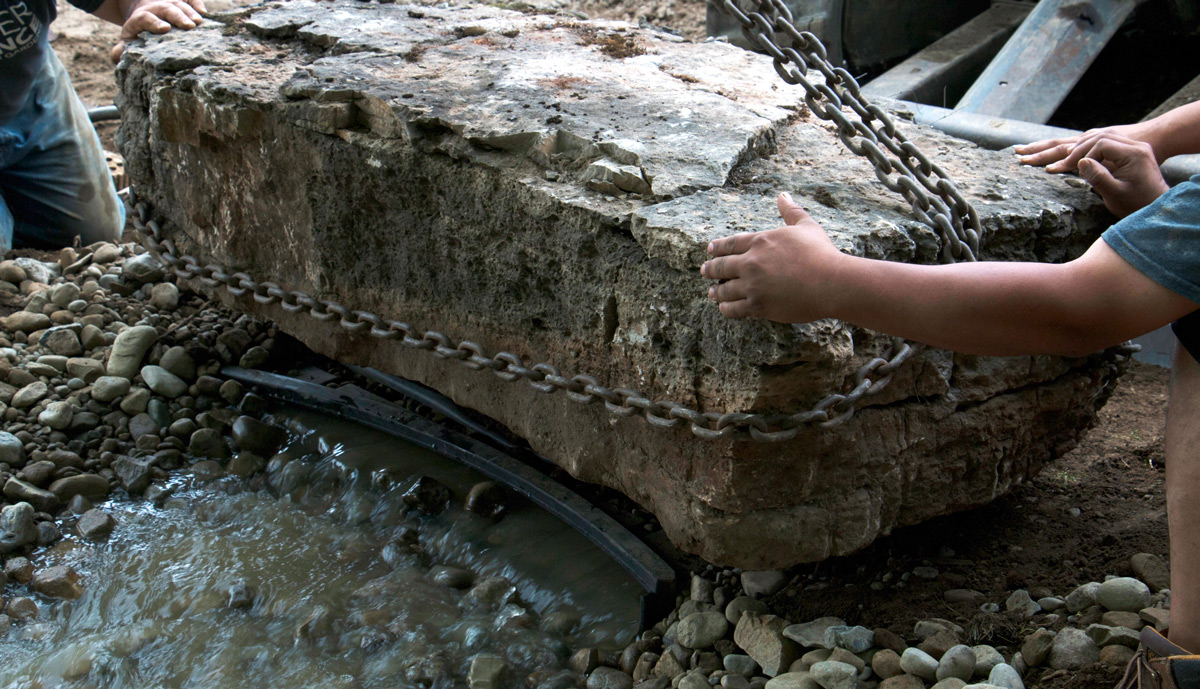Pond-Free 101 Chapter 10
The Waterfall Spillway
The last component we’ll discuss is the waterfall spillway. Regardless of the name – spillway, falls box, diffuser, weir – the idea is the same: these are simple boxes without filtration media that diffuse the jet of water coming out of the hose so the water flows out evenly distributed. The box needs to be strong enough to support the weight of the stones that will conceal it, and some of the best units secure the liner higher than the water outlet to ensure against leaks. These units are very popular because they address three common problems that arise with Pond-free waterfalls. First, they eliminate the dreaded hose-under-a-rock look that distinguishes a newcomer to waterfall construction a mile off. Properly sized, these units diffuse the flow evenly across their entire width without restriction. The second problem is more serious, and can happen even with certain spillways that don’t have a secure method to seal the liner to the box. The pipe coming into the back of the box typically has to come in over the top of the liner, and the boxes are usually set on a mound of excavated soil. The weight of water in the pipe and the constant vibration can settle the pipe down in the mounded soil the boxes are usually set on, carrying the liner down with it. If water can get to the pipe, it can follow the pipe right outside the liner, causing a serious leak. Spillways that hold the liner in place above the level that the water exits the box keep leaks from happening even if the box itself settles over time. Finally, the best waterfall boxes are heavily built, reinforced to support the weight of massive stones so they can be easily hidden in the rockwork of the feature. The Pro FastFalls of Atlantic Water Gardens are good examples of a well-designed spillway. They feature internal buttressing that diffuses the flow of the water and provides massive strength against crushing, and the liner attachment system allows for simple, leak-proof installation directly to Schedule 40 pipe.

The last component we’ll discuss is the waterfall spillway. Regardless of the name – spillway, falls box, diffuser, weir – the idea is the same: these are simple boxes without filtration media that diffuse the jet of water coming out of the hose so the water flows out evenly distributed. The box needs to be strong enough to support the weight of the stones that will conceal it, and some of the best units secure the liner higher than the water outlet to ensure against leaks. These units are very popular because they address three common problems that arise with Pond-free waterfalls. First, they eliminate the dreaded hose-under-a-rock look that distinguishes a newcomer to waterfall construction a mile off. Properly sized, these units diffuse the flow evenly across their entire width without restriction. The second problem is more serious, and can happen even with certain spillways that don’t have a secure method to seal the liner to the box. The pipe coming into the back of the box typically has to come in over the top of the liner, and the boxes are usually set on a mound of excavated soil. The weight of water in the pipe and the constant vibration can settle the pipe down in the mounded soil the boxes are usually set on, carrying the liner down with it. If water can get to the pipe, it can follow the pipe right outside the liner, causing a serious leak. Spillways that hold the liner in place above the level that the water exits the box keep leaks from happening even if the box itself settles over time. Finally, the best waterfall boxes are heavily built, reinforced to support the weight of massive stones so they can be easily hidden in the rockwork of the feature. The Pro FastFalls of Atlantic Water Gardens are good examples of a well-designed spillway. They feature internal buttressing that diffuses the flow of the water and provides massive strength against crushing, and the liner attachment system allows for simple, leak-proof installation directly to Schedule 40 pipe.





